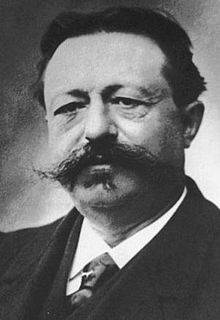Nizier Anthelme Philippe
Nizier Anthelme Philippe , known as Monsieur Philippe or Maître Philippe (born April 25, 1849 in Loisieux , Kingdom of Sardinia , † August 2, 1905 in L'Arbresle , Département Rhône , France ) was a French mystic and occultist .
Life
Career as an occultist
Nizier Anthelme Philippe was born in 1849 in a remote hamlet called Le Rubathier in the municipality of Loisieux in Savoy , which was part of the Kingdom of Sardinia until 1860. His mother Marie Vachot (1823–1899) and his father Joseph Philippe (1819–1898) were farmers. Philippe completed an apprenticeship with a maternal uncle, a butcher in Lyon , and then began studying medicine at that city's university. It is unclear whether he left college voluntarily or was expelled, in any case he never received a medical degree. However, this in no way hampered his career as a healer . According to his own statement, he already had healing powers at the age of thirteen.
After leaving university, he devoted himself intensively to occultism , hypnotism and, as some sources claim, magic as well . In 1877 he married Jeanne Julie Landar, a former patient and daughter of a wealthy industrialist from Lyon. With her he had a daughter and a son who, however, died as a baby. In the early 1880s Philippe set up his own laboratory and began to take in patients whom he treated with various techniques and substances, including what he himself called “psychic fluids and astral forces”. In 1884 he sent the University of Cincinnati under the pseudonym Philippe d'Arbresle a French dissertation under the title Pregnancy, confinement and the hygiene principle to be applied to infants . Thanks largely to the efforts of a colleague, the doctor and occultist Papus , who introduced Philippe to Martinism , his reputation spread. In the press he was hailed as the " Cagliostro of our age". His self-description "I am an absolute nothing" increased the curiosity of his audience.
Contacts with the court of the Tsars
The Russian Count Muravjow-Amurski was at a séance of Philippe in Paris on the occasion of the anniversary of the beheading of Louis XVI. present. The count reported how the master conjured up the spirit of the late king, whereupon a blood-covered head appeared before the eyes of the astonished audience, which suddenly disappeared again into the darkness.
The Grand Duchesses Militza and Anastasia , both very fond of the occult, had met Philippe at the beginning of 1900 and invited him to Russia, where he stayed for months and was introduced to Tsar Nicholas and his wife Alexandra on March 26, 1901 . Nikolaus in particular was drawn to the mysterious Frenchman and had long conversations with him. In church circles and among leading monarchists, the presence of a dubious foreigner who exerted far-reaching influence at the tsar's court and who promised the tsarina a long-awaited son soon provoked a scandal. After investigations by the State Security Service , the Tsar was forced to release Philippe in the summer of 1903. Immediately thereafter, Rasputin took over his place as a miracle worker at the Tsar's court.
Philippe returned to France. A few months after the death of his daughter Victoire Jeanne Philippe (1878-1904), he died on August 2, 1905 in L'Arbresle and was buried in the Loyasse cemetery in the 5th arrondissement of Lyon. His favorite student, Jean Chapas (1863–1932), succeeded his laboratory in Lyon in 1903.
Individual evidence
- ↑ Principe d'hygiène à appliquer dans la grossesse, l'accouchement et la durée des couches.
- ^ Douglas Smith: Rasputin , Monsieur Philippe . Pp. 35-45.
Web links
literature
- Douglas Smith: Rasputin . Macmillan, London 2016. ISBN 978-1-4472-4584-1 .
| personal data | |
|---|---|
| SURNAME | Philippe, Nizier Anthelme |
| ALTERNATIVE NAMES | Monsieur Philippe; Maître Philippe |
| BRIEF DESCRIPTION | French mystic and occultist |
| DATE OF BIRTH | April 25, 1849 |
| PLACE OF BIRTH | Loisieux , Kingdom of Sardinia |
| DATE OF DEATH | 2nd August 1905 |
| Place of death | L'Arbresle , Rhône department , France |

